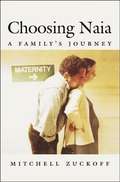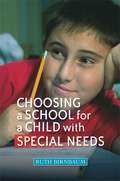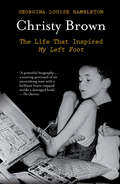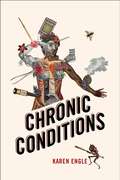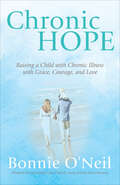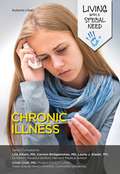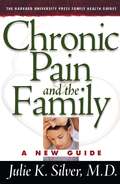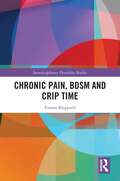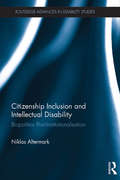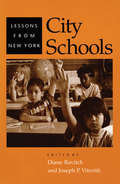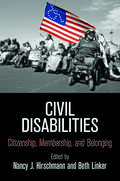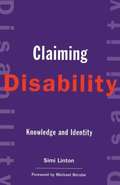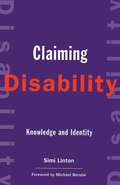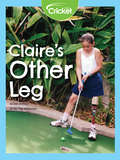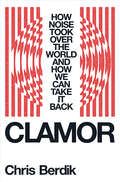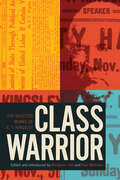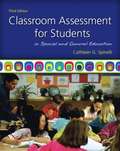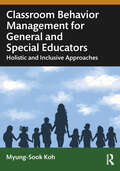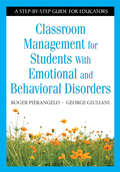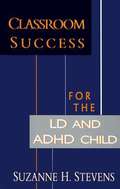- Table View
- List View
Chip: The Story of a Guide Dog Puppy
by Miss Barlow's Fourth through Sixth Grade Special Education Students in Clovis CaliforniaFrom the Book jacket: Chip, The Story of a Guide Dog Puppy, chronicles the life of a guide dog from birth at the kennels to what happens if it does not make it as a working guide dog. Each year the learning handicapped students at Jefferson Elementary School in Clovis, California, welcome a puppy into their classroom to help their teacher socialize it for Guide Dogs for the Blind, Inc. The students wrote and illustrated this award-winning book. Meet the Authors and Illustrators L-R: Brandon Linn, Juston Smart, Megan Johnson, Hazael Gonzalez, Jordan Kedwards, Margaret Maskovich, Dominic Espinoza, Bonnie Jones, Chad Powers, and Hailey Ricord.
Choosing Naia: A Family's Journey
by Mitchell ZuckoffChoosing Naia is a powerful story, based on an award-winning series of articles about a modern family and their Down syndrome baby. A dramatic and carefully detailed account of one family's journey through the maze of genetic counseling, medical technology, and disability rights
Choosing Outcomes and Accommodations for Children: A Guide to Educational Planning for Students with Disabilities (2nd edition)
by Michael F. Giangreco Chigee J. Cloninger Virginia S. IversonRevised in response to research and user feedback, COACH offers you redesigned forms, more explicit instructions, and helpful hints, and tabs and icons so you can easily locate information.
Choosing a School for a Child With Special Needs
by Ruth BirnbaumIf you are considering placing a child with special needs at a new school, it can be difficult to know where to begin. Should you choose a special school, or a special unit within a mainstream school? What will be the involvement of therapists? Maybe home schooling would be best? Whether the child has autism, dyslexia or any other special educational, emotional or behavioural difficulty, this book will help you find the school that suits the child best. From drawing up a list of possibilities and setting up a school visit, to asking the right questions and recording your opinions in order to make an informed decision, Choosing a School for a Child with Special Needs will guide you through this complex and stressful process with confidence and ease. Whether you are a parent seeking a special school, a professional researching a school, or a teacher recommending what to look for in a school, this book is a must-have reference for anyone taking school placement seriously.
Christy Brown: The Life That Inspired My Left Foot
by Georgina Louise HambletonChristy Brown was severely disabled with cerebral palsy, unable to use any part of his body other than his left foot. Doctors said he was a 'mental defective' and that he would never be able to lead any kind of normal life; Christy proved them wrong.His mother taught him to write using chalk on the worn floor of their small home, and Christy grew into a talented artist and writer. His 1954 memoir My Left Foot was made into an Oscar-winning film starring Daniel Day-Lewis, while his bestselling novel Down All the Days was described by the Irish Times as 'the most important novel since Ulysses'.Using previously unpublished letters and poems, this first authorised biography marks Christy Brown's importance as a writer and celebrates his indomitable spirit. His story proves that, with hope and determination, almost impossible odds can be overcome.
Chronic Conditions
by Karen EngleImagine a house whose wiring is spliced and patchy with knob and tube, coiled like a serpent ready to strike and spark at any moment. Even if you have a fire trap behind your walls, the lights will turn on. In her memoir of a life lived in physical pain, Karen Engle asks whether and how language can capture what it’s like to be in a body that appears to work from the outside, when its internal systems operate through an ad hoc assemblage of garbled messaging, reroutings, and shaky foundations. A series of narrative reflections capture the myriad ways in which the chronic conditions its suffering subject. Contrary to claims that pain obliterates language – long a trope of writing about illness – Engle contends that the person with chronic pain is not hampered by a scarcity of language, but rather its excess: enervation by the unending waves of utterance. From a history of the word chronic and its shifting significance to meditations on multiple diagnoses and interactions with medical personnel, Chronic Conditions is a doctor’s case file through the looking glass of a creative writer, scholar, and patient. Engle explores, through medical research, literature, and art, how it feels to become attuned to the rhythms of perpetual and mysterious physical pain. At stake here is the search for a kind of writing that does not instrumentalize pain for allegorical or transcendental purposes. Chronic pain is not a sign of weakness, nor is it an opportunity for personal growth, Engle argues. Instead, it is entirely ordinary and deeply affecting.
Chronic Hope: Raising a Child with Chronic Illness with Grace, Courage, and Love
by Bonnie O’NeilChronic Hope helps parents of children living with chronic disease gain practical wisdom for managing the emotional stress of raising a chronically ill child, so they can navigate these challenges with grace, courage, and love.
Chronic Illness
by Autumn LibalNot every sickness goes away in a few days or weeks. Unfortunately, some can last for months, years, or even the rest of a person's life. When this happens, it is called a chronic illness. It can cause many difficulties in people's lives, besides the illness itself. With some determination and help from friends and professionals, though, people with chronic illnesses can learn to face these challenges. Every young person faces challenges as they grow up, but those who have chronic illnesses have additional hardships. In this book, as you read Kayla's story, you'll learn about some of the difficulties these teenagers must overcome, and you'll discover some of the treatments and support systems that help them. Kids like Kayla have a tough time--but their lives can also be filled with hope!
Chronic Pain and the Family: A New Guide (The Harvard University Press Family Health Guides #1)
by Julie K. SilverChronic pain is the leading cause of disability in the United States, affecting as many as 48 million people in this country alone. It can demoralize and depress both patient and family, especially when there is no effective pain control and no hope for relief. Improperly managed, chronic pain can lead to substance abuse (usually painkillers) and to acute psychological and emotional distress. Pain begets stress and stress begets pain in a wretched downward spiral. Silver reviews the causes and characteristics of chronic pain and explores its impact on individual family relationships and on the extended family, covering such issues as employment, parenting, childbearing and inheritance, and emotional health. Silver treats aspects of chronic pain not covered in a typical office visit: how men and women differ in their experience of chronic pain, the effect of chronic pain on a toddler's behavior or an older child's performance in school, the risks of dependence on and addiction to pain medications, and practical ways for relatives beyond the immediate family circle to offer help and support to the person in pain.
Chronic Pain, BDSM and Crip Time (Interdisciplinary Disability Studies)
by Emma SheppardThis book is a critical disability studies examination of the lived experience of chronic pain, engaging with and making a significant contribution to crip theory and the concept of ‘crip time’. Exploring experiences of pain and fatigue for people who live with chronic pain and based on narratives told through in-depth detailed interviews interwoven with theory at the cutting edge of critical disability studies, it demonstrates that our knowledge and understanding of chronic pain is incomplete without a critical disability studies approach. Through conceptualizing the concept of ‘crip time’ via participants’ narratives of living with chronic pain, chronic fatigue, and variable disabilities, this book demonstrates how thinking about chronic pain and fatigue with ‘crip time’ exposes normative, ableist, assumptions underlying both how pain and the ideas of cure and recovery are understood. It will be of interest to all academics and students working in the fields of disability studies, critical disability studies, crip theory, medical sociology, sexuality, and studies of embodiment, corporeality, and temporality more generally.
Chuskit Goes to School!
by Sujatha PadmanabhanIn the Himalayas, there was a disabled nine-year-old girl, Chuskit, who wanted to go to school, study and do all the things her friends were doing. She however could not get out of her house, until one day Abdul decided to help her.
Circles of Care
by Ann Cason"Written from within the experience of caregiving, Circles of Care recognizes that no one person can handle the strain of caregiving alone, giving many fine suggestions on dealing with the irritation, frustration, and fatigue that inevitably arise. It describes the opportunity that caregivers have to know their subjects intimately and creatively, focusing not on weakness but on strength and on making constructive use of the interests and abilities still available in order to channel the tremendous energy that often remains after nearly everything else is gone."
Citizenship Inclusion and Intellectual Disability: Biopolitics Post-Institutionalisation (Routledge Advances in Disability Studies)
by Niklas AltermarkWhat happens when a group traditionally defined as lacking the necessary capacities of citizenship is targeted by government programs that have made ‘citizenship inclusion’ their main goal? Combining theoretical perspectives of political philosophy, social theory, and disability studies, this book untangles the current state of Western intellectual disability politics following the replacement of state institutionalisation by independent and supported living, individual rights, and self-determination. Taking its cue from Foucault’s conception of ‘biopolitics’, denoting the government of the individuals and the totality of the population, its overarching argument is that the ambiguous positioning of people with intellectual disabilities with respect to the ideals of citizenship results in a regime of government that simultaneously includes and excludes people of this group. On the one hand, its members are projected to become ideal-citizens via the cultivation of citizenship capacities. On the other, the right to live independently and by their own choices is curtailed as soon as they are seen as failing with respect to the ideals of reason and rationality. Therefore, coercion, restraints, and paternalism, which were all supposed to end with deinstitutionalisation, are still ingrained in services targeting the group. In equal parts a theoretical work, advancing debates of critical disability theory, social theory, and post-structural philosophy, as well as an empirical engagement with the history of intellectual disability politics and the ways in which present day politics target the group, this book will be of interest to all students and scholars of disability studies, disability politics, and political theory.
City Schools: Lessons from New York
by Diane Ravitch Joseph P. ViterittiHow the story of NYC's schools contain lessons for other cities.City Schools brings together a distinguished group of researchers and educators for an in-depth look at the nation's largest school system. Topics covered include the changing demographics of city schools, the impending teacher shortage, reading instruction, special education, bilingual education, school governance, charter schools, choice, school finance reform, and the role of teacher unions. City Schools also provides fresh and fascinating perspectives on Catholic schools, Jewish day schools, and historically black independent schools.Diane Ravitch, Joseph P. Viteritti, and their coauthors explore pedagogical, institutional, and policy issues in an urban school system whose challenges are those of American urban education writ large. The authors conclude that we know a lot more about how to provide effective educational services for a diverse population of urban school children than performance data would suggest.Contributors: Dale Ballou, University of Massachusetts, Amherst • Stephan F. Brumberg, Brooklyn College • Mary Beth Celio, University of Washington • Gail Foster, Toussaint Institute • Michael Heise, Case Western University • Clara Hemphill, Public Education Association • Paul T. Hill, University of Washington • William G. Howell, Harvard University • Pearl Rock Kane, Columbia University • Frank J. Macchiarola, Saint Francis College • Melissa Marschall, University of South Carolina • Thomas Nechyba, Duke University • Paul E. Peterson, Harvard University • Christine Roch, Georgia State University • Christine H. Rossell, Boston University • Marvin Schick, Avi Chai Foundation • Mark Schneider, SUNY, Stony Brook • Lee Stuart, South Bronx Churches • Paul Teske, SUNY, Stony Brook • Emanuel Tobier, New York University • Joanna P. Williams, Columbia University
Civil Disabilities: Citizenship, Membership, and Belonging (Democracy, Citizenship, and Constitutionalism)
by Nancy J. Hirschmann Beth LinkerAn estimated one billion people around the globe live with a disability; this number grows exponentially when family members, friends, and care providers are included. Various countries and international organizations have attempted to guard against discrimination and secure basic human rights for those whose lives are affected by disability. Yet despite such attempts many disabled persons in the United States and throughout the world still face exclusion from full citizenship and membership in their respective societies. They are regularly denied employment, housing, health care, access to buildings, and the right to move freely in public spaces. At base, such discrimination reflects a tacit yet pervasive assumption that disabled persons do not belong in society.Civil Disabilities challenges such norms and practices, urging a reconceptualization of disability and citizenship to secure a rightful place for disabled persons in society. Essays from leading scholars in a diversity of fields offer critical perspectives on current citizenship studies, which still largely assume an ableist world. Placing historians in conversation with anthropologists, sociologists with literary critics, and musicologists with political scientists, this interdisciplinary volume presents a compelling case for reimagining citizenship that is more consistent, inclusive, and just, in both theory and practice. By placing disability front and center in academic and civic discourse, Civil Disabilities tests the very notion of citizenship and transforms our understanding of disability and belonging.Contributors: Emily Abel, Douglas C. Baynton, Susan Burch, Allison C. Carey, Faye Ginsburg, Nancy J. Hirschmann, Hannah Joyner, Catherine Kudlick, Beth Linker, Alex Lubet, Rayna Rapp, Susan Schweik, Tobin Siebers, Lorella Terzi.
Claiming Disability: Knowledge and Identity
by Simi LintonDisability studies in the humanities curriculum
Claiming Disability: Knowledge and Identity (Cultural Front #14)
by Simi LintonA comprehensive assessment of the field of Disability Studies that presents beyond the medical to dig into the meaningFrom public transportation and education to adequate access to buildings, the social impact of disability has been felt everywhere since the passage of the Americans with Disabilities Act in 1990. And a remarkable groundswell of activism and critical literature has followed in this wake. Claiming Disability is the first comprehensive examination of Disability Studies as a field of inquiry. Disability Studies is not simply about the variations that exist in human behavior, appearance, functioning, sensory acuity, and cognitive processing but the meaning we make of those variations. With vivid imagery and numerous examples, Simi Linton explores the divisions society creates—the normal versus the pathological, the competent citizen versus the ward of the state. Map and manifesto, Claiming Disability overturns medicalized versions of disability and establishes disabled people and their allies as the rightful claimants to this territory.
Claire's Other Leg
by Deb AronsonClaire Williams was born with one leg much smaller than the other, but she doesn’t let that stop her from playing sports, jumping on trampolines, or wearing high heels! Read about how Claire is living a full life with the aid of a prosthetic leg.
Clamor: How Noise Took Over the World - and How We Can Take It Back
by Chris BerdikA May 2025 Next Big Idea Club Must-Read Book An eye- (and ear-) opening investigation into how our ever-noisier world affects our health, our well-being, and our planet. Early-morning jackhammering from construction down the block. The dull roar of jets flying overhead. Your office mates’ phone conversations. We are surrounded by noise, but it is a problem many of us shrug off once the immediate annoyance passes. Yet as gifted science journalist Chris Berdik explains in Clamor, noise can have serious health effects, disrupting our sleep, ratcheting up our stress, and destroying our concentration. As he argues, it is one of the most pervasive, yet underacknowledged, pollutants in our daily lives—one that we neglect, both individually and systemically, at our peril Drawing on extensive research and original reporting, Berdik shows how a too-limited understanding of noise, focused on loud sounds and decibel counts, has undermined a century of noise-control efforts and obscured the full toll noise exacts on us and the environment. Chronic exposure to noise that falls below decibel-based thresholds—sometimes even below our conscious awareness—is linked to spikes in the risk of heart disease and other serious health ailments that contribute to premature death. Noisy classrooms hinder developing minds and delay cognitive milestones. In forests and in the depths of the ocean, a cacophony of manmade sound disrupts the natural soundscape, threatening animals’ capacity to communicate, hunt, and flee predators. Yet in the battle against noise, sound doesn’t have to be our enemy: Berdik introduces us to the researchers, rock stars, architects, and many others who are finding surprising ways to make our world sound not only less bad, but better. Rising above the ever-increasing racket, Clamor is an urgent—and ultimately inspiring—call to finally take noise seriously and harness sound’s great potential.
Class Warrior: The Selected Works of E. T. Kingsley
by Eugene Thornton KingsleyIn October 1890, Eugene T. Kingsley’s life changed irrevocably when he was injured in a fall between two rail cars while working as a brakeman on the Northern Pacific Railway. Following the amputation of both his legs, Kingsley became radicalized and joined the Socialist Labor Party in San Francisco. His activism eventually brought him to Vancouver, B.C. where he founded the Socialist Party of Canada. A self-described “uncompromising enemy of class rule and class robbery,” Kingsley wrote prolifically on the exploitation of wage slaves by the capitalist class. Also known as a passionate orator, he went on to become one of the most prominent socialist intellectuals of his day. Class Warrior is a collection of Kingsley’s writing and speeches that underscores his tremendous impact on Canadian political discourse.
Classroom Assessment for Students in Special and General Education (Third Edition)
by Cathleen G. SpinelliClassroom Assessment for Students in Special and General Education is written for future teachers and experienced educators who are interested in developing or expanding their understanding of effective and reflective assessment practices. This new edition, with its emphasis on progress monitoring and early intervention, aligns well with the practical, authentic, and informal assessment procedures that have been--and continue to be--the heart of this edition and of past editions of this text.
Classroom Behavior Management for General and Special Educators: Holistic and Inclusive Approaches
by Myung-Sook KohThis comprehensive textbook outlines a holistic approach to inclusive classroom management. It critically examines the limitations inherent in behaviorism-based methods— particularly the Positive Behavior Interventions and Supports (PBIS) framework rooted in Applied Behavior Analysis (ABA)— and offers an alternative that integrates the full spectrum of student needs and the complexities of modern educational dynamics. Addressing the interconnected crises of falling academic standards, rising teacher turnover, and growing student behavioral and emotional challenges, the book presents a comprehensive, actionable strategy for accurately identifying classroom deficiencies and effectively responding to them in a student-centered way. Applicable to both special education and general educational contexts, Classroom Behavior Management for General and Special Educators is key reading for pre-service teachers in classroom and behavior management courses, as well as in-service teachers, teacher educators, and school administrators seeking new ways to address student behavior.
Classroom Management Techniques for Students With ADHD: A Step-by-Step Guide for Educators
by Roger Pierangelo George A. GiulianiDiscover practical methods for teaching students with Attention Deficit Hyperactivity Disorder, including effective strategies for classroom management, behavioral intervention, meeting legal requirements, and academic instruction.
Classroom Management for Students With Emotional and Behavioral Disorders: A Step-by-Step Guide for Educators
by Roger Pierangelo George A. GiulianiThis comprehensive guide covers typical emotional and behavioral disorder (EBD) behaviors, effective instructional interventions, positive reinforcement techniques, federal regulations, promoting healthy social interactions, and classroom management strategies.
Classroom Success for the LD and ADHD Child
by Suzanne H. StevensFor years, the assumption has been that it is mainly parents who need to be shown how to help their LD/ADHD children. This book is unique in its emphasis on educating teachers and other professionals as well as mothers and fathers—all those who must join efforts to lead LD/ADHD children to academic success. <p><p> Author Suzanne H. Stevens also knows the importance of recognizing the unusual creativity and other abilities found among LD/ADHD children, abilities long neglected by a system bent on forcing them into a mold they do not fit. <p> Stevens offers practical suggestions on: <p> recognizing the LD/ADHD child <p> adjusting teaching techniques <p> using specialists effectively <p> adjusting classroom management procedures <p> testing and grading fairly <p> The result is a balanced, optimistic look at ways of helping an increasing number of children reach their full potential in class.

